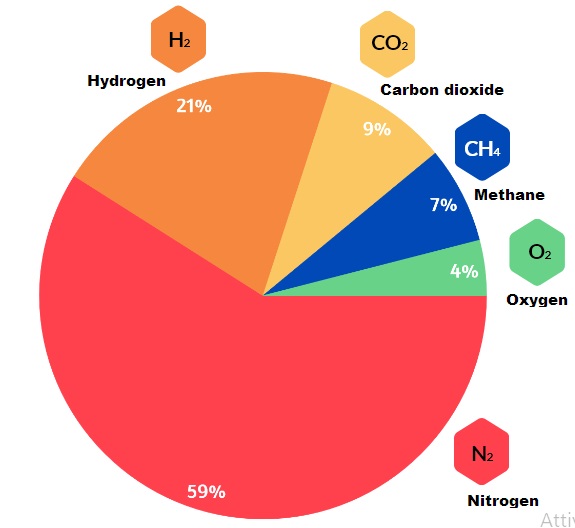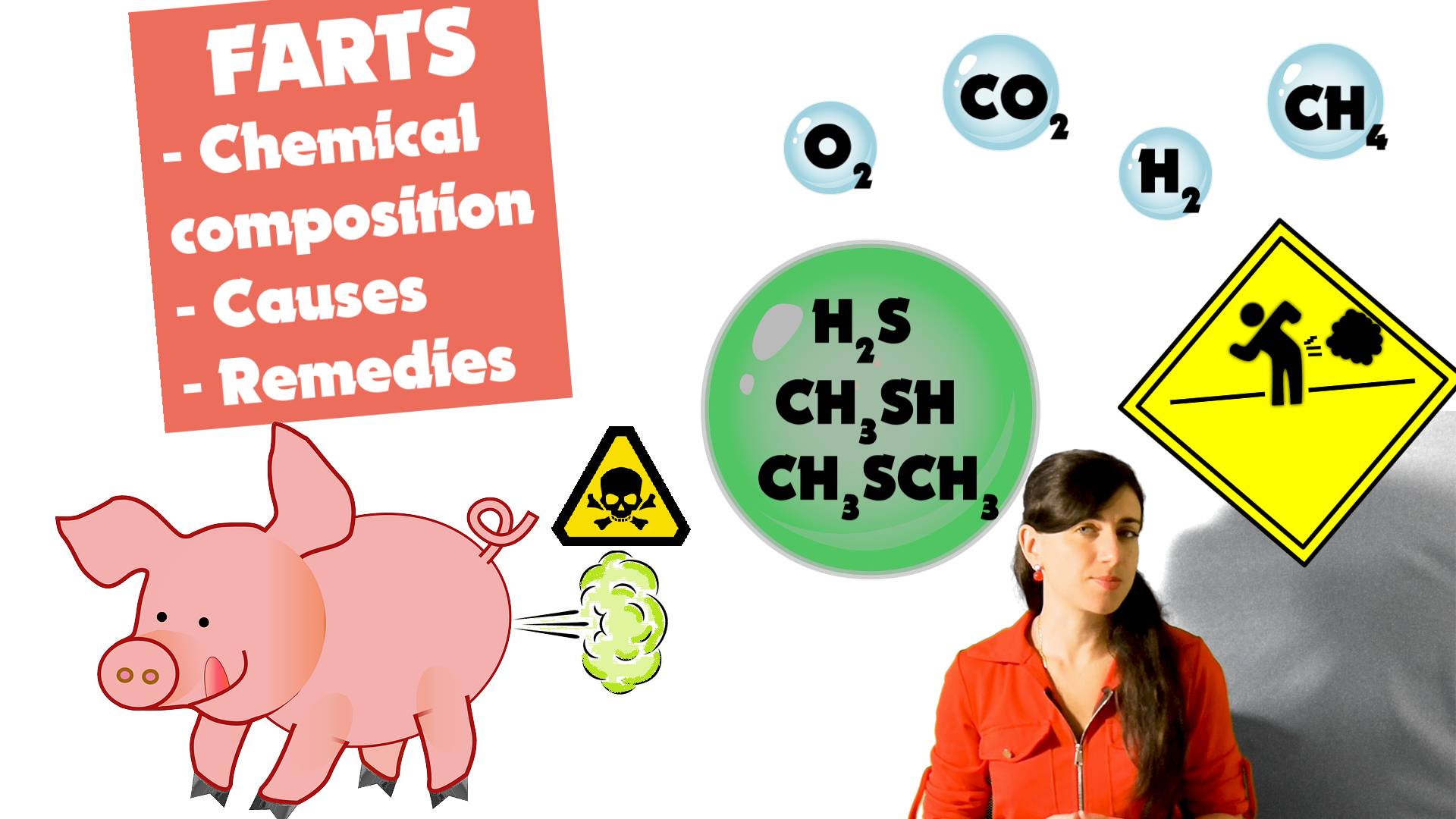Introduction
The emission of air from the backside is something that characterizes us all, including animals. However, this topic always makes us uncomfortable, mainly due to the bad smell that often comes along with the bang. Indeed, although one can willingly bear one’s own emissions and perhaps even like them, in case of excessive self-love, it will be more difficult to bear the flatulence of others.
In this article, we are going to understand more about the phenomenon of flatulence, in particular we are going to see the chemical composition of farts, the causes and possible remedies for the bad smell.
Terms
The loud emission of intestinal gases through the anal orifice is called by common people with various colourful terms: farts, toots, cut the cheese, let one rip, trumps, blow off, etc. In the scientific field, these terms are not acceptable; therefore, scientists switch to a more refined language that allows them to treat the phenomenon with a proper behaviour and detachment. Indeed, they use the term
FLATULENCE, which comes from the Latin flatus, meaning breath.
Chemical composition
But what’s inside a fart? Oops, flatus!
The 99% of the emissions are made up of odourless gases of the following average composition:
- 59% N2
- 21% H2
- 9% CO2
- 7% CH4
- 4% O2

The exact percentages may vary from individual to individual depending on age, diet, ethnic group, etc. As it can be seen from the above list or from the pie chart (Figure 1), most of the gas emitted is nitrogen, one of the major components of the atmosphere. This gas is found in our emissions because when we eat or drink, we swallow the outside air too. If this air is not erupted (in jargon burping), from the stomach it passes through the gut and inevitably comes out of the last of our holes. The other major component is hydrogen, produced by the bacteria in our intestines, followed by CO2 and CH4, which are also mainly produced by bacteria.
Looking at the chemical composition, two important conclusions can be deduced:
- Some of these gases are flammable (Figure 2), such as hydrogen and methane. This is the reason why some people cheerfully set farts on fire by placing a lighter near the place of the exit.
- These gases does not smell at all. All five are odourless.
So how do farts smell bad?
The answer is in the remaining 1%. In fact, this is the quantity in which sulphur-based gases are present, such as hydrogen sulphide, H2S, with the smell of rotten eggs, methanethiol, CH3SH, with the smell of rotten vegetables and dimethyl sulphide, C2H6S which releases a sweet smell but not at all pleasant because it is similar to that of cabbage.
These gases are so foul smell that a trace presence is enough, like in our farts, to create a perceptible smell.

Production
A healthy human being on average emits 22 flatuses per day, each of the volume of a golf ball. The quantity emitted during the day is by no means negligible; in fact, it corresponds to a volume of 1 to 2 L of air. For a worldwide emission equivalent to 7-14 billion liters per day!
Causes
But what is the cause of these frequent emissions? The first cause is the air we inadvertently swallow while eating or drinking. It is estimated that for 10 ml of water drunk a person also incorporates up to 17 ml of air. Therefore, if on average we drink 1 to 2 liters of water a day, it means that we swallow several liters of air just by drinking. Some of this air is emitted by belching, but some passes from stomach to the intestines, and then exits out through the rectum. The air absorbed by swallowing is mainly composed of nitrogen and oxygen, the two major components of the air.
Besides swallowing, however, there are three other mechanisms of flatulence:
- The interaction between bicarbonate and acids, responsible for the formation of CO2;
- The diffusion of CO2 and O2 from the blood;
- The metabolism of bacteria present in the intestinal tract. These bacteria produce O2, CO2, H2, CH4 and the disgusting sulphur-based compounds responsible for the bad smell.
Remedies to reduce excessive flatulence
One of the remedies to cut the cheese less is definitely to control the diet. In fact, excessive consumption of legumes, especially beans and peas, leads to a greater probability of high flatulence. Other foods on the blacklist are milk and dairy products, but also all foods rich in carbohydrates (e.g. flour-based products, such as pasta, pizza, bread, etc.).
However limiting these foods is very difficult; therefore, another possibility could be to eliminate exclusively the products rich in sulphur-based compounds, in order to reduce at least the bad smell of the lethal and often silent toots. These foods are cruciferous vegetables, i.e. red cabbage, black cabbage, broccoli, cauliflower, savoy cabbage, curly cabbage, Brussels sprouts, turnip tops, but also radish, mustard, horseradish and rocket.
This last strategy, however, would only eliminate part of the bad smells, since a certain percentage of sulphur-based compounds is directly produced by the bacteria in our intestines regardless of our diet.
Therefore, with the strategies listed above, in addition to continuous food sacrifices and stress in food control, we would not even be sure of the success of the operation.
Luckily, though, business-minded scientists have devised cushion lined with highly porous charcoal that can be installed directly into your underwear and can reduce the nasty smell coming from sulphur compounds by as much as 90%. Therefore, thanks to this invention, we can fart healthy wherever we want without holding back or limiting ourselves in diet. An amazing invention, which however has the only limitation of not taking into account the thunderous bang that often comes along with the gas, making us suspicious to prying ears. Science has not found a solution to this, but with a little cunning, a remedy could always be found, such as trying to cover the noise by coughing, dropping an object or screaming.
Conclusion
Well thanks to this article, you will now be able to cut the cheese freely, but remember the saying: ‘’’whoever smelt it, dealt it!’’ Therefore, if you are tempted to point your finger at naive people who do not have an anti-odour cushion, and try to mock them, you will have to hold your mouth because of this popular belief. However, in the end it will only be a small effort compared to the freedom gained from no longer holding the sphincters.

References
1) Suarez, F. L., & Levitt, M. (2000). An understanding of excessive intestinal gas. Current Gastroenterology Reports, 2(5), 413–419. https://doi.org/10.1007/s11894-000-0042-8
2) Price, K. R., Lewis, J. M., Wyatt, G. M., & Fenwick, G. R. (1988). Review article Flatulence — Causes, relation to diet and remedies. Die Nahrung, 32(6), 609–626. https://doi.org/10.1002/food.19880320626
This article

Flatulence
€
1.50
Download pdf (unchangeable)

Flautulence
€
2.20
Download docx (changeable)



